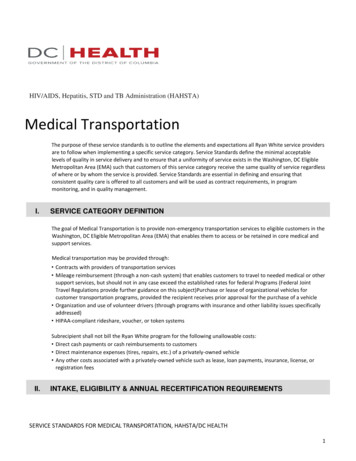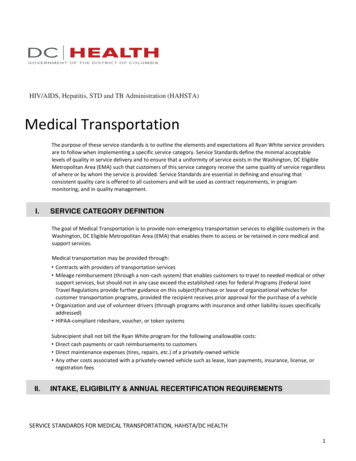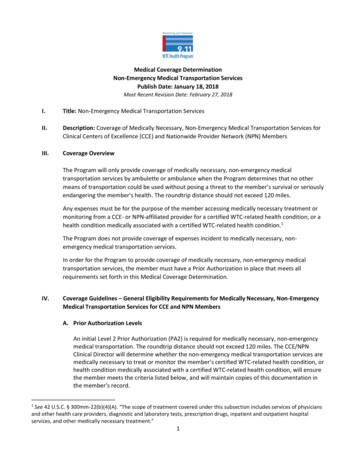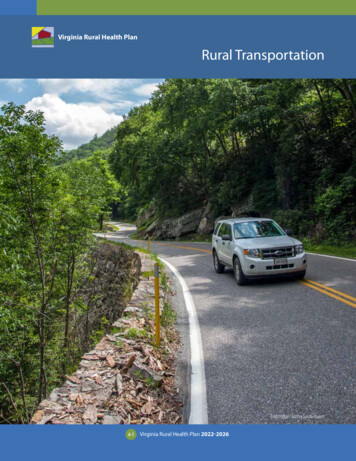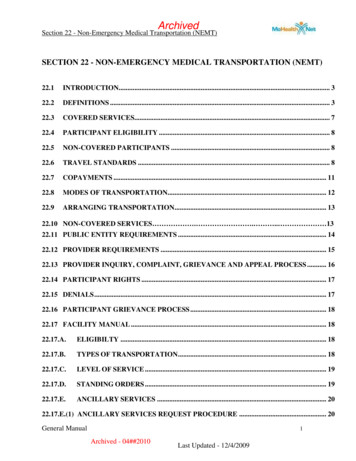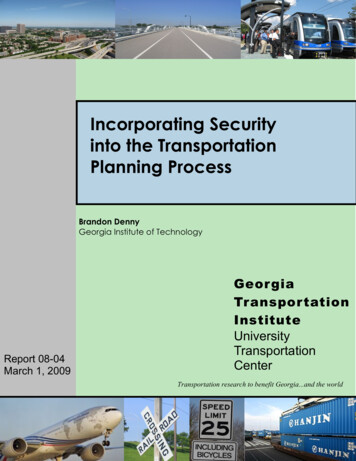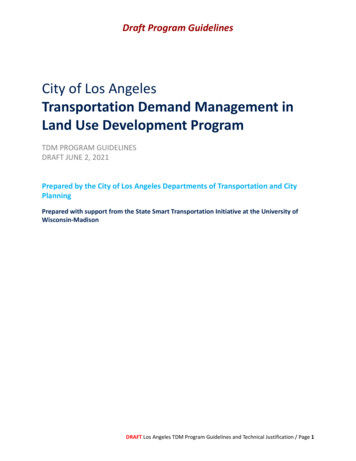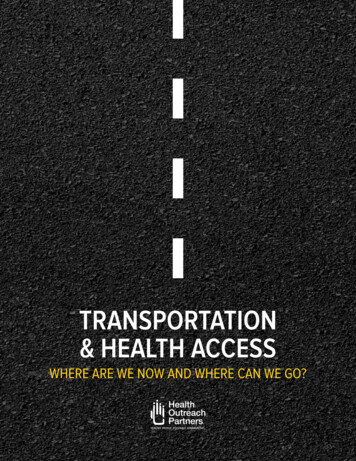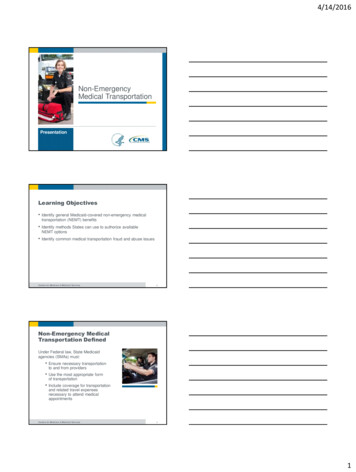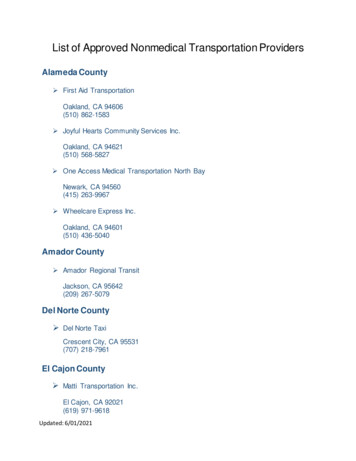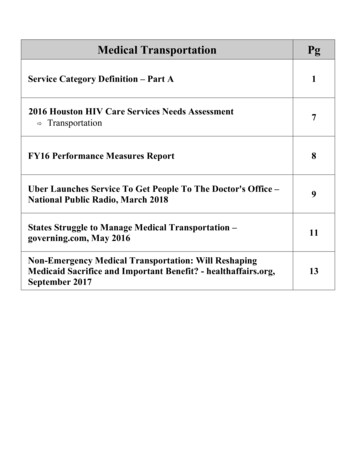
Transcription
Medical TransportationPgService Category Definition – Part A12016 Houston HIV Care Services Needs Assessment Transportation7FY16 Performance Measures Report8Uber Launches Service To Get People To The Doctor's Office –National Public Radio, March 20189States Struggle to Manage Medical Transportation –governing.com, May 201611Non-Emergency Medical Transportation: Will ReshapingMedicaid Sacrifice and Important Benefit? - healthaffairs.org,September 201713
1 of 16FY 2018 Houston EMA/HSDA Ryan White Part A Service DefinitionMedical Transportation (Van Based)(Revision Date: 03/03/14)HRSA Service CategoryMedical TransportationTitle: RWGA OnlyLocal Service Categorya. Transportation targeted to UrbanTitle:b. Transportation targeted to RuralBudget Type:Hybrid Fee for ServiceRWGA OnlyBudget Requirements or Units assigned to Urban Transportation must only be used toRestrictions:transport clients whose residence is in Harris County.RWGA Only Units assigned to Rural Transportation may only be used totransport clients who reside in Houston EMA/HSDA countiesother than Harris County. Mileage reimbursed for transportation is based on thedocumented distance in miles from a client’s Trip Origin to TripDestination as documented by a standard Internet-basedmapping program (i.e. Google Maps, Map Quest, YahooMaps) approved by RWGA. Agency must print out and filein the client record a trip plan from the appropriate Internetbased mapping program that clearly delineates the mileagebetween Point of Origin and Destination (and reverse for roundtrips). This requirement is subject to audit by the County. Transportation to employment, employment training, school, orother activities not directly related to a client’s treatment of HIVdisease is not allowable. Clients may not be transported toentertainment or social events under this contract. Taxi vouchers must be made available for documented emergencypurposes and to transport a client to a disability hearing,emergency shelter or for a documented medical emergency. Contractor must reserve 7% of the total budget for TaxiVouchers. Maximum monthly utilization of taxi vouchers cannot exceed14% of the total amount of funding reserved for Taxi Vouchers. Emergencies warranting the use of Taxi Vouchers include: vanservice is unavailable due to breakdown, scheduling conflicts orinclement weather or other unanticipated event. A spreadsheetlisting client’s 11-digit code, age, date of service, number oftrips, and reason for emergency should be kept on-site andavailable for review during Site Visits. Contractor must provide RWGA a copy of the agreementbetween Contractor and a licensed taxi vendor by March 30,2015. All taxi voucher receipts must have the taxi company’s name, thedriver’s name and/or identification number, number of milesdriven, destination (to and from), and exact cost of trip. TheContractor will add the client’s 11-digit code to the receipt andinclude all receipts with the monthly Contractor Expense Report
2 of 16HRSA Service CategoryDefinition:RWGA OnlyLocal Service CategoryDefinition:(CER). A copy of the taxi company’s statement (on company letterhead)must be included with the monthly CER. Supportingdocumentation of disbursement payments may be requested withthe CER.Medical transportation services include conveyance services provided,directly or through voucher, to a client so that he or she may accesshealth care services.a. Urban Transportation: Contractor will develop and implement amedical transportation program that provides essential transportationservices to HRSA-defined Core Services through the use of individualemployee or contract drivers with vehicles/vans to Ryan White Programeligible individuals residing in Harris County. Clients residing outsideof Harris County are ineligible for Urban transportation services.Exceptions to this requirement require prior written approval fromRWGA.b. Rural Transportation: Contractor will develop and implement amedical transportation program that provides essential transportationservices to HRSA-defined Core Services through the use of individualemployee or contract drivers with vehicles/vans to Ryan White Programeligible individuals residing in Houston EMA/HSDA counties other thanHarris County. Clients residing in Harris County are ineligible for thistransportation program. Exceptions to this requirement require priorwritten approval from RWGA.Essential transportation is defined as transportation to public and privateoutpatient medical care and physician services, substance abuse andmental health services, pharmacies and other services where eligibleclients receive Ryan White-defined Core Services and/or medical andhealth-related care services, including clinical trials, essential to theirwell-being.The Contractor shall ensure that the transportation program provides taxivouchers to eligible clients only in the following cases: To access emergency shelter vouchers or to attend socialsecurity disability hearings; Van service is unavailable due to breakdown or inclementweather; Client’s medical need requires immediate transport; Scheduling Conflicts.Contractor must provide clear and specific justification (reason) forthe use of taxi vouchers and include the documentation in theclient’s file for each incident. RWGA must approve supportingdocumentation for taxi voucher reimbursements.For clients living in the METRO service area, written certification
3 of 16from the client’s principal medical provider (e.g. medical casemanager or physician) is required to access van-based transportation,to be renewed every 180 days. Medical Certifications should bemaintained on-site by the provider in a single file (listedalphabetically by 11-digit code) and will be monitored at leastannually during a Site Visit. It is the Contractor’s responsibility todetermine whether a client resides within the METRO service area.Clients who live outside the METRO service area but within HarrisCounty (e.g. Baytown) are not required to provide a written medicalcertification to access van-based transportation. All clients living inthe Metro service area may receive a maximum of 4 non-certifiedround trips per year (including taxi vouchers). Non-certified trips willbe reviewed during the annual Site Visit. Provider must maintain anup-to-date spreadsheet documenting such trips.Target Population (age,gender, geographic, race,ethnicity, etc.):Services to be Provided:Service Unit Definition(s):RWGA OnlyFinancial Eligibility:Client Eligibility:The Contractor must implement the general transportation program inaccordance with the Transportation Standards of Care that includeentering all transportation services into the Centralized Patient CareData Management System (CPCDMS) and providing eligible childrenwith transportation services to Core Services appointments. Onlyactual mileage (documented per the selected Internet mappingprogram) transporting eligible clients from Origin to Destination willbe reimbursed under this contract. The Contractor must makereasonable effort to ensure that routes are designed in the mostefficient manner possible to minimize actual client time in vehicles.a. Urban Transportation: HIV/AIDS-infected and Ryan White PartA/B eligible affected individuals residing in Harris County.b. Rural Transportation: HIV/AIDS-infected and Ryan White Part A/Beligible affected individuals residing in Fort Bend, Waller, Walker,Montgomery, Austin, Colorado, Liberty, Chambers and WhartonCounties.To provide Medical Transportation services to access Ryan WhiteProgram defined Core Services for eligible individuals.Transportation will include round trips to single destinations andround trips to multiple destinations. Taxi vouchers will be provided toeligible clients only for identified emergency situations. Caregivermust be allowed to accompany the HIV-infected rider. Eligibility forTransportation Services is determined by the client’s County ofresidence as documented in the CPCDMS.One (1) unit of service one (1) mile driven with an eligible client aspassenger. Client cancellations and/or no-shows are not reimbursable.Refer to the RWPC’s approved Financial Eligibility for Houston EMAServices.a. Urban Transportation: Only individuals diagnosed with HIV/AIDSand Ryan White Program eligible HIV-affected individuals residinginside Harris County will be eligible for services.
4 of 16b. Rural Transportation: Only individuals diagnosed with HIV/AIDSand Ryan White Program eligible HIV-affected individuals residing inHouston EMA/HSDA Counties other than Harris County are eligiblefor Rural Transportation services.Documentation of the client’s eligibility in accordance with approvedTransportation Standards of Care must be obtained by the Contractorprior to providing services. The Contractor must ensure that eligibleclients have a signed consent for transportation services, client rightsand responsibilities prior to the commencement of services.Agency RequirementsAffected significant others may accompany an HIV-infected person asmedically necessary (minor children may accompany their caregiveras necessary). Ryan White Part A/B eligible affected individuals mayutilize the services under this contract for travel to Core Services whenthe aforementioned criteria are met and the use of the service isdirectly related to a person with HIV infection. An example of aneligible transportation encounter by an affected individual istransportation to a Professional Counseling appointment.Proposer must be a Certified Medicaid Transportation Provider.Contractor must furnish such documentation to Harris County uponrequest from Ryan White Grant Administration prior to March 1stannually. Contractor must maintain such certification throughout theterm of the contract. Failure to maintain certification as a MedicaidTransportation provider may result in termination of contract.Contractor must provide each client with a written explanation ofcontractor’s scheduling procedures upon initiation of their firsttransportation service, and annually thereafter. Contractor must provideRWGA with a copy of their scheduling procedures by March 30, 2014,and thereafter within 5 business days of any revisions.Contractor must also have the following equipment dedicated tothe general transportation program: A separate phone line from their main number so that clients canaccess transportation services during the hours of 7:00 a.m. to 10:00p.m. directly at no cost to the clients. The telephone line must bemanaged by a live person between the hours of 8:00 a.m. – 5:00p.m. Telephone calls to an answering machine utilized after 5:00p.m. must be returned by 9:00 a.m. the following business day. A fax machine with a dedicated line. All equipment identified in the Transportation Standards of Carenecessary to transport children in vehicles. Contractor must assure clients eligible for Medicaid transportationare billed to Medicaid. This is subject to audit by the County.The Contractor is responsible for maintaining documentation to evidencethat drivers providing services have a valid Texas Driver’s License and
5 of 16Staff RequirementsSpecial Requirements:RWGA Onlyhave completed a State approved “Safe Driving” course. Contractormust maintain documentation of the automobile liability insurance ofeach vehicle utilized by the program as required by state law. Allvehicles must have a current Texas State Inspection. The minimumacceptable limit of automobile liability insurance is 300,000.00combined single limit. Agency must maintain detailed records ofmileage driven and names of individuals provided with transportation, aswell as origin and destination of trips. It is the Contractor’sresponsibility to verify the County in which clients reside in.A picture identification of each driver must be posted in the vehicleutilized to transport clients. Criminal background checks must beperformed on all direct service transportation personnel prior totransporting any clients. Drivers must have annual proof of a safedriving record, which shall include history of tickets, DWI/DUI, orother traffic violations. Conviction on more than three (3) movingviolations within the past year will disqualify the driver. Convictionof one (1) DWI/DUI within the past three (3) years will disqualify thedriver.Individuals who qualify for transportation services through Medicaidare not eligible for these transportation services.Contractor must ensure the following criteria are met for allclients transported by Contractor’s transportation program:Transportation Provider must ensure that clients use transportationservices for an appropriate purpose through one of the following threemethods:1. Follow-up hard copy verification between transportationprovider and Destination Agency (DA) program confirminguse of eligible service(s), or2. Client provides receipt documenting use of eligible services atDestination Agency on the date of transportation, or3. Scheduling of transportation services was made by receivingagency’s case manager or transportation coordinator.The verification/receipt form must at a minimum include all elementslisted below: Be on Destination Agency letterhead Date/Time CPCDMS client code Name and signature of Destination Agency staff member whoattended to client (e.g. case manager, clinician, physician,nurse) Destination Agency date stamp to ensure DA issued form.
6 of 16FY 2019 RWPC “How to Best Meet the Need” Decision ProcessStep in Process: CouncilRecommendations:Approved: Y: No:Approved With Changes:Date: 06/14/18If approved with changes listchanges below:1.2.3.Step in Process: Steering CommitteeRecommendations:Approved: Y: No:Approved With Changes:Date: 06/07/18If approved with changes listchanges below:1.2.3.Step in Process: Quality Improvement CommitteeRecommendations:Approved: Y: No:Approved With Changes:Date: 05/15/18If approved with changes listchanges below:1.2.3.Step in Process: HTBMN WorkgroupRecommendations:1.2.3.Financial Eligibility:Date:04/25/18
7 of 16TRANSPORTATIONTransportation services provides transportation to persons living with HIV (PLWH) to locations where HIV-relatedcare is received, including pharmacies, mental health services, and substance abuse services. The service can beprovided in the form of public transportation vouchers (bus passes), gas vouchers (for rural clients), taxi vouchers(for emergency purposes), and van-based services as medically indicated.(Graph 1) In the 2016 Houston HIV CareServices Needs Assessment, 47% ofparticipants indicated a need for transportationservices in the past 12 months. 40% reportedthe service was easy to access, and 7%reported difficulty. 10% stated they did notknow the service was available. Whenanalyzed by type transportation assistancesought, 84% of participants needed buspasses, 10% needed van services, and 6%needed both forms of assistance.(Table 1) When barriers to transportation serviceswere reported, the most common barrier typewas transportation (28%). Transportationbarriers reported include both lack oftransportation and difficulty with specialtransportation providers.TABLE 1-Top 5 Reported Barrier Types forTransportation Services, 2016No.%1.Transportation (T)928%2.Education and Awareness (EA)619%3.Eligibility (EL)413%4.Accessibility (AC)39%5.Resource Availability (R)39%GRAPH 1-Transportation Services, 201643%45%40%30%25%20%15%10%7%10%5%0%Did not knowabout serviceDid not needserviceNeeded theNeeded theservice, easy service, difficultto accessto access(Table 2 and Table 3) Need and access to services can beanalyzed for needs assessment participants according todemographic and other characteristics, revealing the presenceof any potential disparities in access to services. Fortransportation services, this analysis shows the following: More females than males found the service accessible. More African American/black PLWH found the serviceaccessible than other race/ethnicities. More PLWH age 50 found the service accessible thanother age groups. In addition, more transgender, recently released, unstablyhoused, and MSM PLWH found the service difficult toaccess when compared to all 8-2425-4950 Did not know about service11%8%7%9%15%13%22%10%9%Did not need service47%31%55%36%41%87%43%44%40%Needed, easy to access35%55%27%48%38%0%30%38%44%Needed, difficult to access8%6%10%8%5%0%4%8%7%TABLE 3-Transportation Services, by Selected Special Populations, 2016Out ofRecentlyUnstablyCarecReleaseddExperience with the ServiceHousedaMSMba 84%-Bus 10%-Van 6%-Both35%TABLE 2-Transportation Services, by Demographic Categories, 2016SexRace/ethnicityExperience with the Service40%Rurale TransgenderfDid not know about service17%13%50%8%6%14%Did not need service27%49%50%22%72%18%Needed, easy to access46%31%0%59%16%50%Needed, difficult to access10%8%0%11%6%18%Persons reporting housing instability bMen who have sex with men cPersons with no evidence of HIV care for 12 mo.Persons released from incarceration in the past 12 mo. eNon-Houston/Harris County residents fPersons with discordant sex assigned at birth and current genderdPage 71
8 of 16Umair A. Shah, M.D., M.P.H.Executive Director2223 West Loop SouthHouston, Texas 77027Tel: (713) 439-6000Fax: (713) 439-6080Brian C. Reed, M.DDirector,Disease Control & Clinical Prevention Division2223 West Loop SouthHouston, Texas 77027Tel: (713) 439-6000Fax: (713) 439-6199FY 2016 PERFORMANCE MEASURES HIGHLIGHTSRYAN WHITE GRANT ADMINISTRATIONHARRIS COUNTY PUBLIC HEALTH (HCPH)Ryan White Part AHIV Performance MeasuresFY 2016 ReportTransportationVan-Based TransportationFY 2015FY 2016ChangeA minimum of 50% of clients will utilize Parts A/B/C/D primarycare services after accessing Van Transportation services464(68.8%)493(69.1%)0.3%35% of clients will utilize Parts A/B LPAP services after accessingVan Transportation services345(51.2%)386(54.1%)2.9%Bus Pass TransportationFY 2015FY 2016ChangeA minimum of 50% of clients will utilize Parts A/B/C/D primarycare services after accessing Bus Pass services898(34.3%)914(37.3%)3.0%A minimum of 20% of clients will utilize Parts A/B LPAP servicesafter accessing Bus Pass services440(16.8%)535(21.8%)5.0%A minimum of 65% of clients will utilize any RW Part A/B/C/D orState Services service after accessing Bus Pass services1,993(76.2%)1,955(79.7%)3.5%HCPH is the local public health agency for the Harris County, Texas jurisdiction. It provides a wide variety of public health activities andservices aimed at improving the health and well-being of the Harris County community.Follow HCPH on Twitter @hcphtx and like us on Facebook
9 of 16National Public Radio (NPR) - March 1, 2018 9:00 AM ETProducer: Emily SullivanUber Launches Service To Get People To The Doctor's OfficeUber wants to get you from your home to your doctor's office — and you won't even needto open the Uber app. The company announced Thursday that it's teaming up with healthcare organizations to provide transportation for patients going to and from medicalappointments.The rides can be scheduled for patients through doctor's offices, by receptionists or otherstaffers. And they can be booked for immediate pickup or up to 30 days in advance. Thatmeans patients without a smartphone — who wouldn't be able to use Uber otherwise —can become Uber customers.Instead of operating through an app, Uber Health will send its passengers' rideinformation through an SMS text message. The company also plans to introduce theoption for passengers to receive a call with trip details to their landline instead. Driverswill still use the Uber smartphone app to pick up these passengers."Transportation barriers are the greatest for vulnerable populations," says Chris Weber,the general manager of Uber Health. "This service will provide reliable, comfortabletransportation for patients."Cities With Uber Have Lower Rates Of Ambulance UsageTransportation is, indeed, a barrier to good health care. Affordable access to a vehicle isconsistently associated with increased access to medical care, according to a study.Around 3.6 million Americans miss doctor's appointments or delay medical care due to alack of transportation every year, according to the National Conference of StateLegislatures.To meet the medical privacy standards outlined in the federal HIPAA law, drivers won'tknow which of their passengers are using Uber Health. Like a typical Uber ride, only apassenger's name, pickup and drop-off addresses will be given to the driver. So Uberdrivers won't be able to opt into the health service the same way that they opt into UberEats, a food delivery service.Peter Whorley, who drives a Honda Odyssey minivan for Uber in Fort Lauderdale, Fla.,often picks up passengers who need the extra space, including patients traveling to andfrom doctor's offices.I:\HTBMN\FY2019 HTBMN April-May 2018\Wgs\3\Transportation\Uber for Healthcare NPR 03-01-18.docx
10 of 16No Car, No Care? Medicaid Transport Program Faces Cuts In SomeStates"I just picked up someone with back surgery the other day," he says. "I like to help people,if they need extra assistance, I personally don't have that problem. But some people mightbe squeamish, and not want to."Whorley, who has been driving for Uber for more than two years, is more skeptical aboutpicking up people without smartphones. He thinks location tracking on smartphones isvital to the efficiency of the ride-hailing service. "When you're a good passenger, youshould be able to have your phone out to communicate with your driver," he says.Uber's Weber says that because health care providers will use their best discretion inscheduling the rides, they won't call Ubers for people in need of urgent medical attention."It's not a replacement to ambulances," he says, but a reliable means of transportation tonon-urgent medical services that he hopes will curb missed appointments.One hundred health care organizations in the U.S., including hospitals, clinics, rehabcenters, senior care facilities, home care centers, and physical therapy centers havealready used Uber Health's test program. The service will be rolled out to health careorganizations gradually.I:\HTBMN\FY2019 HTBMN April-May 2018\Wgs\3\Transportation\Uber for Healthcare NPR 03-01-18.docx
http://www.governing.com/templates/gov print article?id 37714975111 of 16Millions of disabled, sick and elderly people rely on medical transportation that canleave them stranded for hours in times of need.BY: Katherine Barrett & Richard Greene May 2016The dialogue around providing accessible health care includes such big issues as high-priced prescriptions,overuse of emergency rooms and a burgeoning need for long-term care. One topic that gets relatively littleattention, but could have a big impact on accessibility, is transportation. It represents a tiny fraction of thetotal spent on health care, but it has been a big challenge for states to manage.This piece of the health-care puzzle affects 7.1 million people, according to the nonprofit Altarum Institute,which provides health-care research and consulting. A chunk of this group are Medicaid patients. Thefederal government requires transportation reimbursement for all Medicaid recipients.A report to the 2015 National Conference of State Legislatures described the extent of the overall problem.“Services can overlap in some areas and be entirely absent in others,” it said, noting that funding shortfalls,policy and implementation failures, and lack of coordination leave many who need transportation with few orno options.Often the service shortfalls are as mundane as cars that show up late -- sometimes 15 minutes, sometimeshours. Or worse, they don’t arrive at all. This is more than an inconvenience. It can be devastating,particularly when the patients involved are frail or disabled and trying to get home from an appointment.Nathalie Molliet-Ribet, senior associate director of Virginia’s Joint Legislative Audit and Review Commissionnotes, for instance, how traumatic it would be for, say, an intellectually disabled child to be left alone forhours while waiting for a ride home.Poor service isn’t the only issue states have to deal with. There have been a host of instances in whichstates wind up overpaying for transportation or paying for transportation that wasn’t necessary in the firstplace.Massachusetts, for example, audited a company that had contracted to provide wheelchair van servicesbased on a fee-for-service model. When Massachusetts examined the books, the state auditor’s office foundthat:More than 17 million in questionable payments were made to the provider for wheelchair vantransportation.Hundreds of claims were made for members who were inpatients at hospitals at the time the allegedtransportation was proffered.16 percent of transportation services to methadone clinics occurred with members who were notreceiving any medical services.In a model of understatement, State Auditor Suzanne Bump says that “the administration of the program hasnot been its strong suit.” The provider’s failure to comply with the terms of the program was so blatant, sheadds, “it blew the auditors and me away.”How did the provider respond to the publication of these problems? They said that they were acting underthe direction of MassHealth, the state’s Medicaid and children’s health insurance program. MassHealthdenies that was the case. The provider has been suspended, and the attorney general’s office isinvestigating. Meanwhile, Medicaid recipients, with the help of MassHealth, have been scrambling to findother ways to get to their medical appointments.
http://www.governing.com/templates/gov print article?id 37714975112 of 16The problems with nonemergency medical transportation in Virginia have been somewhat different. As manystates do, Virginia uses a single broker to match transportation providers with Medicaid recipients. Under thecontract, the broker is paid a fixed rate per enrollee. But the broker has claimed to be unable to cover itscosts, arguing that the service rate set in its contract is too low. There is no demonstrated cause and effectbetween the reimbursement rate and the quality of service, but there would appear to be a link. The statehas experienced an increased rate of complaints from patients about unfulfilled trips.One of the challenges in fixing the problem was a lack of data. “Medicaid didn’t have any information onwhether the broker was losing money, and why,” says Molliet-Ribet. A year ago, the state did a study andfound enough justification to provide an increase in reimbursement.But the broker continues to claim not to have enough money, and the state doesn’t appear willing to raise itsrates again since “the broker has been unwilling or unable to provide [necessary] information,” says MollietRibet. In the meantime, the auditor’s office has been pushing for greater transparency in order to deal fairlywith its broker and optimize quality of service.It’s not all failure out there. One state that has run a particularly efficient nonemergency medicaltransportation program is Vermont. The state is largely rural, and a lot of citizens live far away from medicalfacilities. As a result, many Medicaid recipients do not have easy access to health care. What’s more, thenumber of transportation-needy Medicaid recipients has been growing as a result of Medicaid expansionand an increase in the number of patients with addiction-related problems.Vermont has taken a multiprovider approach to managing the transportation challenge. It gives 12 separateproviders wide latitude to provide rides. “It’s their responsibility to develop their own transportation plans,”says Suellen Bottiggi, who heads up Medicaid provider relations. But that’s only the first part of theirapproach. The second is to practice oversight -- each of the 12 is audited once or even twice a year.“Ongoing monitoring is so important,” says Bottiggi.Regardless of the public-sector service, we can’t repeat that sentiment often enough. There’s nothing like afocused look at the books to keep providers on their toes.This article was printed from: dicaltransportation.html
0920.062063/full/13 of 16Michael Adelberg Marsha Simon, September 20, 2017Medicaid delivers care to 74.5 million individuals for less money than any other large-scale health financingmechanism. A 2016 Henry J. Kaiser Family Foundation study noted that “spending per enrollee is lower forMedicaid compared to private insurance after controlling for differences in sociodemographic and healthcharacteristics between the two groups.” One reason might be that Medicaid covers certain inexpensive, nonmedical services that, when delivered early in the progression of chronic diseases, can check or slow thediseases, thereby improving beneficiaries’ health and saving money. One non-medical service—transportationto medical appointments—has been part of Medicaid since its inception in 1966 and addresses one of thesocioeconomic disadvantages that prevent Medicaid beneficiaries from accessing health services. It issuggested that 3.6 million Medicaid beneficiaries “miss or delay care” annually due to transportationproblems. Although non-emergency medical transportation (NEMT) is a mandatory Medicaid benefit, statescan limit its availability through federal waivers. As Medicaid enters a period of unprecedentedexperimentation and, potentially, reduced federal resources, NEMT remains a critical feature of the program.Since its inception, Medicaid has provided beneficiaries with transportation to medically necessary health careservices. NEMT is found as early as 1966 in the “Handbook of Public Assistance” (Supplement D), theprogram’s earliest comprehensive federal interpretive guidance. Additionally, as part of the Early and PeriodicScreening, Diagnostic, and Treatment (EPSDT) benefit, sta
Medical transportation services include conveyance services provided, directly or through voucher, to a client so that he or she may access health care services. Local Service Category Definition: a. Urban Transportation: Contractor will develop and implement a medical transportation program that provides essential transportation
